Slow Feed Solutions for Farm Animals - Goats, Sheep, Alpacas & More
Read on to learn about the numerous benefits and options for your farm and zoo buddies - plus how foraging differs for browsers vs grazers.
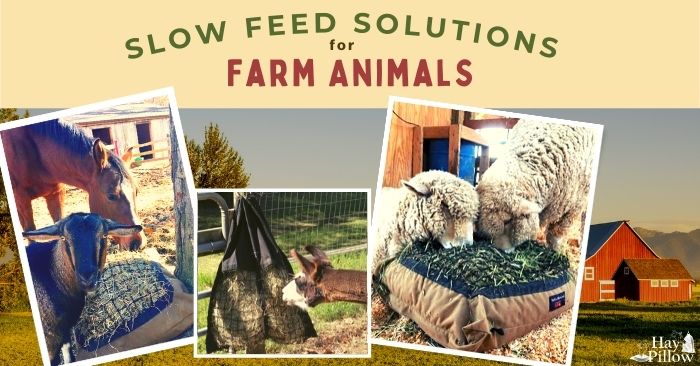
- Goats and sheep
- Llamas, alpacas and camels
- Horses, donkeys, mules and zebras
Slow feeding hay requires individuals to eat smaller amounts over a longer period of time. This concept simulates natural free-choice foraging - and provides a host of physical and mental benefits. A slow feeding program can be accomplished by using a variety of slow feeders best suited to your unique environment, weather conditions and species.
Foraging by Design - Browsers Vs. Grazers
Browsers - such as goats, alpacas, llamas and camels - are designed to primarily forage on leaves, buds and twigs from shrubs, bushes or trees. Therefore, their eyes are positioned centered and more upright on their head with their neck naturally in a more upright position.
Grazing animals - such as sheep, horses, donkeys, mules and zebras - are designed to primarily forage on grasses and vegetation in close proximity to the ground. Their eyes are positioned high on the sides of the head with a lower natural neck position.
Although browsers graze and grazers browse, always consider your animal's natural design when choosing a slow feeder. Do they forage primarily by:
- Grazing - with a lower natural neck position? Grazers (sheep, horses, donkeys, mules and zebras) are better suited to foraging from a ground slow feeder, where they can eat in a natural grazing position.
- Browsing - with a more natural upright head position? Browsers (goats, alpacas, llamas, and camels) will be most comfortable with a hanging slow feeder.
7 Benefits of Free Choice Slow Fed Forage
1. Drastically Reduce Wasted Hay
2. Relaxed Mental State
3. Improved Digestion
Trickle feeding throughout the day and night will:
- Promote consistent fermentation while feeding the beneficial gut microorganisms, effectively keeping the digestive tract healthy and motile;
- Aid in the prevention of conditions that can contribute to colic or bloat.
Chew time is critical mentally and physically for herbivores. Using slow feeders increases chew time per pound and further reduces particle size. Chewing activates saliva production, which provides moisture (higher saliva to forage ratio) and aids in digestion. It's a perfect balance if we follow nature's design.
4. Minimize or Alleviate Boredom
- Chewing on inanimate objects
- Cribbing
- Weaving/Pacing
- Self mutation
- Stall kicking
- Pawing
5. Weight Management
For underweight individuals, slow feeding can aid in digestion and assimilation of calories and nutrients.
6. Natural Wear of Teeth
7. Omission of Stress in Your Life
To Conclude
Herbivores were not designed to thrive on a high-calorie, nutrient-deficient diet comprised of meals. By providing free-choice forage, you will have a healthier, more content herd with the bonus of no longer being committed to multiple feedings day and night!
What Our Farm Animal Friends Say
"We have two horses and three goats who love the 2 Standard Hay Pillows we have. The goats love to lay against a full pillow and munch in the sunshine on these cold winter days, but often the horses bump them away. All the animals are voting for more hay pillows (they prefer them over the other hay bags, nets and slow feeders we've tried)." ~Makendra~
"I love this hanging bag for my goats. They now have hay available 24/7. I no longer have to spend time cleaning up wasted trampled hay or go out to feed early in the morning." ~ Diane ~
"We recently purchased 2 mini hay pillows for the Grevy’s zebras at the Sacramento Zoo. The girls love them! All three of our older gals spend more time moving around the exhibit eating in a natural head down grazing position. And they love to throw the pillows around as well. Wonderfully enriching for our animals and great for the guests watching them eat and play." ~Melissa~
"My three mini-donkey Jennets LOVE their Hay Pillows. I love the savings from reduced hay loss, easier to clean stall floors, reduced aggression since each has their own pillow and their attention is focused on it not each other and my goal is that it will be successful in their losing weight without my being hated for it." ~Fred~
"The hay pillow isn't just great for horses! Clarabelle the mini zebu cow loves her new mini sized hay pillow. It allows her to eat much slower to keep her gut moving (after a very scary situation where her gut was not moving at all!) She loves it and can still easily eat all of the hay inside." ~ Sarah~
"My four goats, two donkeys and two pigs are a lover of your product! I would love to add another hay pillow to our collection. We feel that it allows them to feed in a natural way without the waste or ability to eat too fast." ~ Karen W. ~
Helpful How To Resources
- Grass Hay vs Pellets, Cubes & Chopped Hay – Pros & Cons
- Are You a Prisoner of Feeding? Here's How I Broke Free
- 6 Great Reasons to Feed Your Horse from Ground Level
- 7 Slow Feed Dos and Dont's for Horses
- 7 Easy Ways to Help Prevent Colic
- Causes of Equine Ulcers – 7 Stress Factors & Solutions
- Never Exercise Horses on an Empty Stomach...Ever
- Why You Shouldn't Transport Horses On An Empty Stomach
- Keeping Horses Warm Naturally – Internally and Externally
- Why Most Horses Prefer to Eat Outside
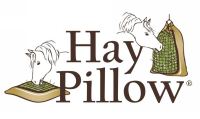
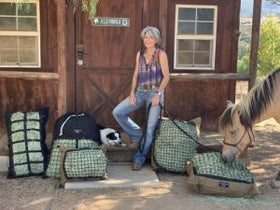
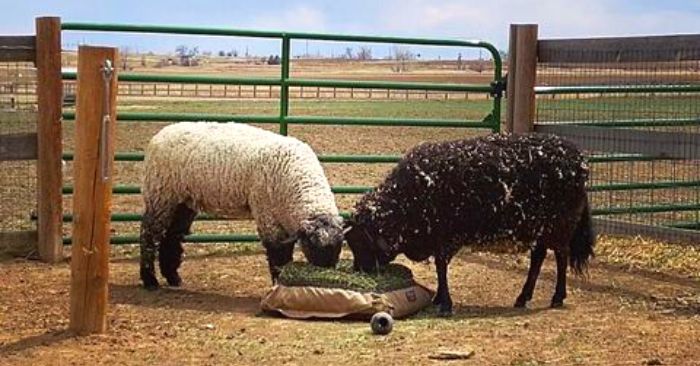








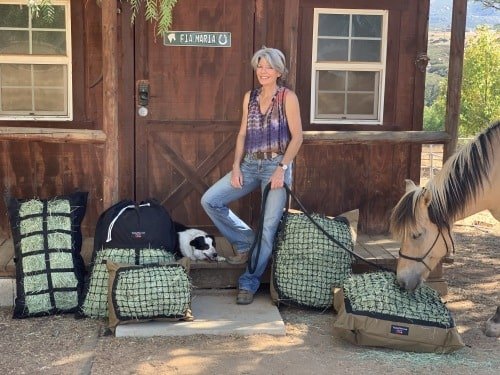
3 Comments -
Sheri L. Harrison • -
Jacqueline • -
Dawn •
Our two horses were unknowingly being fed compromised hay one summer. We proceeded to have about 3 years of very sick horses. They had obtained the heaves or lung damage due to breathing in dust and or mold from the hay. They were receiving an inhaler to help them breath, and an antihistamine in their food. Both horses were getting secondary infections on and off during that time. The only way to get a handle on it was to feed them hay that had been soaked in water (in a tub) not just water sprinkled on it, but soaked,0 to wash away the dust, etc. We live off grid and this was a grueling process in the winter. I was at my wits end, when I saw an add for your hay pillows. I had been looking for a hay feeder, but your hay pillows caught my eye. I read everything that was written about them. Ordered two standard size to try them, and will never feed without them again. The boys (Thor and Brodie) received a clear bill of health this past fall when I had my vet come for a before winter check up. They now have hay all day long, they enjoy eating it from the pillows, and most importantly, dust and debris are not floating through the air as it did while they were eating it from the ground or from the hay feeders secured to the barn walls. My vet was in amazement at their improvement. She wanted to know what I had done. I of course showed her the hay pillows and shared all of the important qualities. It has been a year now and the pillows are still hanging tough. I have bought one for my best friends horses, one for my neices’s horse, and two more for my own. One additional hay pillow and a hay net that I leave as additional if they finish the hay pillow before the evening feed time. I am so thankful to have come across your advertisment and your explainations. Thank you, sincerely.
I like to use slow feed bags. Need to get one for my new adopted donkey.
Our goats would love one of the hay pillows. We give them a hay bag and they go through hay so quick and a lot of waste .🙏